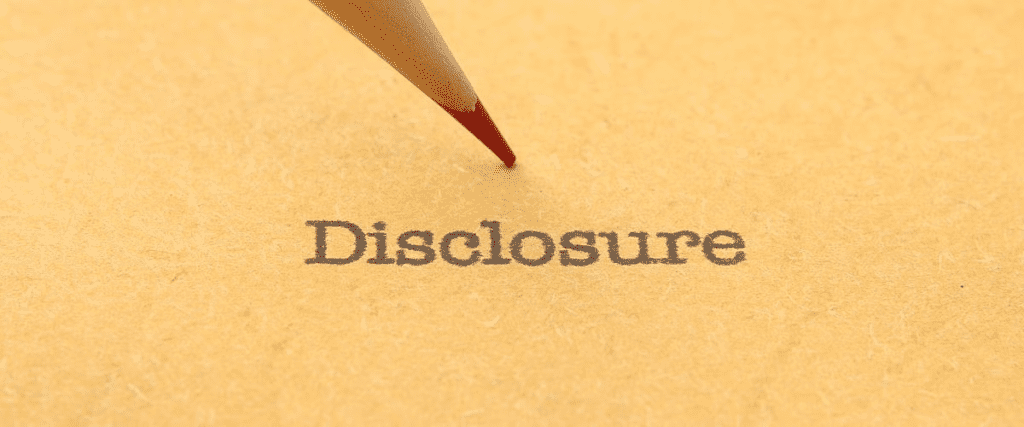You’ve probably seen blogs and online businesses post disclaimers and disclosures on their web pages. Disclaimers and disclosures serve different purposes, but many people often use them interchangeably.
Regardless if you are a consumer or an owner of an online business, you should understand the difference between the two. Doing so will help you have a clearer idea of how you should take in or curate the content of a website for a better online experience.
Table of Contents
PRO TIP: Take the hassle of writing your own disclaimer away with our disclaimer generator trusted by over 200,000 businesses. It’ll save you hours of work and possible costly legal mistakes.
Understanding disclaimers and disclosures
Disclosures and disclaimers can get confusing at the beginning, but you’ll be able to quickly differentiate the two once you get the hang of it. Knowing what makes a disclaimer different from disclosure is necessary, especially if you run a blog or any other online business.
By doing so, you’ll be able to use these accurately and adhere to the legal requirements of the Federal Trade Commission (FTC).
What is a disclaimer?

A disclaimer is a type of notice you place on your online page to limit your liability related to the content you publish on your website and the outcome of the activities available on your website.
Almost all online entities use disclaimers to avoid legal issues. Of course, that doesn’t mean that you will be able to prevent all legal issues from appearing altogether. However, having a disclaimer will protect your business’ interest preemptively.
Coverage of disclaimers
Your disclaimer’s coverage can be targeted to one element, but it can also cover your whole website. When it comes to disclaimer coverage, the best place to start would be the content of your website.
You may have accidentally provided incorrect information that led to damages or had a backend error that resulted in issues with the way you presented your content. Technically, the affected individuals can try to hold you liable in court. However, having a disclaimer will serve as a blanket of protection that can help you argue about your limited liability.
Apart from the content of your website, some of the things that disclaimers may also cover include copyright issues and computer virus transmission, among others.
What should be included in a disclaimer?
Having a personalized disclaimer that would cover your whole practice is ideal. Here is some of the information you would typically include in a disclaimer:
Information accuracy disclaimer
If there are ever unintentional errors on your web page, you will have protection against legal action. Make sure to include the fact that you do not guarantee the information on your pages and you won’t be held liable should issues arise.
Content ownership
You should have ownership over the content you publish on your website. That way, no one will copy your content or use it for their own gain.
Third-party disclaimer
This clarifies that you may have no control over the content posted by others on your website.
Physical liability
Make sure to also include this so that any physical harm that resulted from your goods and services is without your control. Of course, this is not a free pass for you to show off damaged goods and services.
It should be noted that you cannot just copy anyone else’s disclaimer. You should craft your own so that it would be tailor-fitted to the type of content you use and provide.
What is a disclosure?

A disclosure is a notice or a statement that lets your users know about relevant information (like sponsorships and tie-ups) that could help them make informed decisions within your website.
It’s like a fine print that lists down your affiliations so that they know the extent of your relationship with external parties. In the US, the Federal Trade Commission requires websites to disclose their relationship with other brands if they use affiliate links on their websites.
Qualities of a good disclosure
For a disclosure to be considered a good one, there are a couple of requirements that they must meet.
First, your disclosure should be clear and straightforward. There’s no need to second-guess your relationship with external parties. You must directly inform your online customers regarding your affiliation so that they can gauge the possible influence of that third-party affiliate towards your content.
Second, your good disclosure should also be concise. There’s no need to beach around the bush – inform your online customers regarding your affiliations in a short and straightforward manner to avoid facing miscommunication issues.
The placement of your disclosure also matters too. This shouldn’t be buried in your other pages. Instead, you should place this near your recommendations or other affiliate links so that they’d be able to see these details immediately.
Where to place a disclosure on a website?
As mentioned, disclosures should be placed in areas where they can be seen immediately. If possible, these need to stand out either through the use of bigger font size, a different color, or a placement type.
Disclosures need to be placed near triggering items. That means that they must be placed where they can be easily seen, like in the reviews section or an endorsement section on your website. It shouldn’t be placed on just one page only. Disclosures must be present on every page that has your affiliate links and branded content.
Finally, disclosures should be placed somewhere where users will not be required to scroll down anymore. That way, this will be one of the first elements the user will see once they enter your online platform.
Disclosures basically alert your audience regarding a possible bias influenced by affiliations of a website with external parties. These details shouldn’t be a secret, especially since websites need to be more transparent to their users nowadays.
Disclosures not only serve as a need-to-know for your online consumers but also makes your relationship with your clients more honest and sincere.
Final words
By now, you should know the major differences between disclaimers and disclosures already. Just in case – the former limits your liability to the content you post on your website, while the latter clarifies how your content can be influenced by external factors. They may sound alike, but their function in a website is drastically different.
Having them readily available on your website will give you peace of mind since you’ll have a shield against legal issues and you’ll be more honest with your clients regarding your affiliations.



